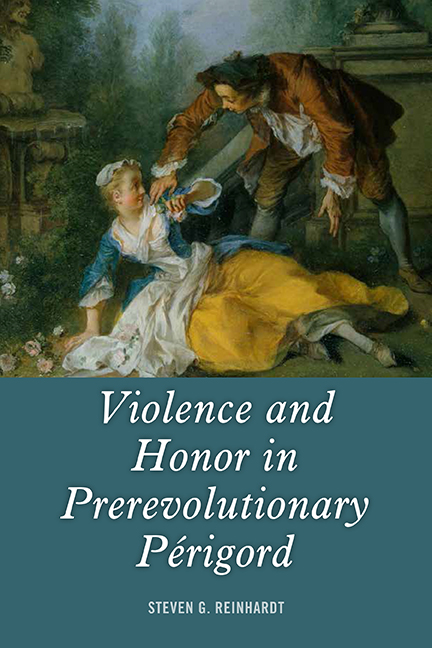Book contents
- Frontmatter
- Dedication
- Contents
- Acknowledgments
- Maps
- Introduction: “The Saint of Honor”
- 1 Violence and Honor
- 2 Honor in a Cross-Cultural Context
- 3 From Honor to Honnêteté in Old Regime Europe
- 4 “The Good Old Days” in Prerevolutionary Sarladais
- 5 “The Saint of Honor” in the Sénéchaussée of Sarlat
- 6 Women and Honor-Related Criminal Affaires
- 7 Policing Honnêteté: Shameful, Sinful, and Criminal Conduct
- 8 “Fallen Women” and Infanticide
- 9 Compromised Honor and Dangerous Liaisons
- 10 Honor and Homicide
- Conclusion
- Notes
- Bibliography
- Index
7 - Policing Honnêteté: Shameful, Sinful, and Criminal Conduct
Published online by Cambridge University Press: 10 June 2021
- Frontmatter
- Dedication
- Contents
- Acknowledgments
- Maps
- Introduction: “The Saint of Honor”
- 1 Violence and Honor
- 2 Honor in a Cross-Cultural Context
- 3 From Honor to Honnêteté in Old Regime Europe
- 4 “The Good Old Days” in Prerevolutionary Sarladais
- 5 “The Saint of Honor” in the Sénéchaussée of Sarlat
- 6 Women and Honor-Related Criminal Affaires
- 7 Policing Honnêteté: Shameful, Sinful, and Criminal Conduct
- 8 “Fallen Women” and Infanticide
- 9 Compromised Honor and Dangerous Liaisons
- 10 Honor and Homicide
- Conclusion
- Notes
- Bibliography
- Index
Summary
The civilizing process entailed promoting desirable behavior and anathematizing undesirable conduct. Vengeful yet measured violence was part of peasant sociability and a familiar means—along with infra-judicial methods of peaceful dispute resolution—of addressing conflict in a society of status. In the sixteenth and seventeenth centuries, however, Church and Crown in France launched a joint campaign to properly Christianize and civilize society. Fifty years ago, Michel Foucault noted that “the constitution of an absolute monarchy and the intense Catholic renaissance during the Counter-Reformation produced in France a very particular character of simultaneous competition and complicity between the government and the Church.” Working in tandem, they attempted to break the populace's age-old addiction to violence by initiating a campaign designed to teach people habits of self-discipline and to accustom them to resolving disputes through legal channels.
An integral part of the elite campaign to control violence and sponsor legalization was, of course, the punishment of a wider assortment of sinful acts that were newly classified as illegal. As described by Zoë A. Schneider, lower-level royal courts (bailiwicks and sénéchaussées) were instrumental in this development: “As sins were gradually redefined as crimes, the men on the benches of the ordinary courts were left to regulate the morals and the conformity of the king's subjects (albeit with varying degrees of enthusiasm and rigor). By the seventeenth century, they did so with far greater reach and independence than they had ever done before, poaching the jurisdictions of the officialités (church courts) and minor civil courts alike.” This chapter evaluates the success of this dual campaign to suppress behavior that was once considered sinful and shameful but subsequently criminalized. According to the new civility propounded by civil and religious hierarchies, sex was not to be discussed openly in polite society and was to be practiced discreetly within the confines of marriage—following the rules laid down by the Church. In practice, however, elite libertines in Paris consciously rebelled against the new moral order; in the Sarladais, peasants also managed to ignore many of the sexual directives of their curés. They did, nonetheless, actually welcome the reformed marital ethic that reinforced the strictures of a culture of honor.
- Type
- Chapter
- Information
- Violence and Honor in Prerevolutionary Périgord , pp. 141 - 169Publisher: Boydell & BrewerPrint publication year: 2018

